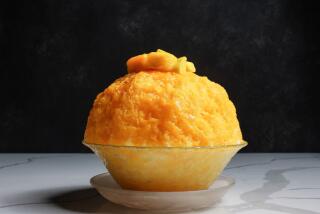The Fruits of No Labor
- Share via
Serving dessert to finish a meal is often a problem for those who are short of time and those with limited cooking skills. We Americans have never really embraced the practice of serving fresh fruit as a satisfying end to lunch or dinner, but we should.
The following are some very simple ways to give fruit more appeal.
In a very good old California recipe, for instance, persimmons are frozen, sliced, then sprinkled with brown sugar and served with yogurt.
The Italian way of serving bunches of grapes is in a bowl of ice and water accompanied by cheese and crackers.
Papaya becomes a beguiling dessert when sprinkled with a few crunchy, peppery papaya seeds and a little lime juice. Cut the papaya in half and seed it, saving one tablespoon of the seeds. Rinse the seeds and sprinkle them over the fruit, and squeeze the juice of half a lime over the top.
Dates and figs are luscious stuffed with a soft cheese and served with walnuts.
Elevate oranges from snack to dessert by mixing them with orange marmalade. Peel four or five oranges, cut them into bite-size cubes or section pieces of orange by cutting the flesh from within the white membrane. Stir 1/2 cup orange marmalade with the orange pieces and chill until time to serve.
Inside-out mango is a civilized way of preparing mangoes, making it possible to eat them at the table. (Most people eat mangoes standing over the sink, letting the juices drip.) Hold the mango vertically on a board. Cut as close as possible along either side of the long, flat pit with a paring knife. Hold one half in the palm of your hand and cut a pattern like tick-tack-toe squares on the flesh without cutting through the skin. Push the skin side of the half upward at the center, as if to turn inside out, so the cut squares protrude. Repeat with the other half. The mango will look quite tailored and will be much easier to eat.
One of the best companions to all fruits is yogurt, and homemade yogurt is leagues better than what you buy in the store. Not only is it more wholesome, it is much cheaper than buying ready-made. Flavor your yogurt with fresh fruits and berries, preserves or grated lemon zest.
You do have to have a yogurt starter, though, and since most of us don’t have friends we can get it from, you will probably have to start with commercial yogurt for your first batch. But after that, you’re set. Save some of the yogurt from the first batch you make for the starter of your next batch. With each succeeding batch, your yogurt will get better and better.
HOMEMADE YOGURT
1 quart milk
2 tablespoons plain yogurt
Bring milk just to boil in saucepan over medium heat, about 1 minute. Let cool to 115 degrees.
Gently stir in 2 tablespoons fresh plain yogurt (the starter) and pour into crockery or glass bowl. Cover snugly with plastic wrap and set in warm spot. (Gas oven with just its pilot light on or electric oven with its interior light burning is ideal. Or put it in warm corner of kitchen draped with a blanket to protect from drafts.)
Let sit until it holds together when bowl is tilted, 5 to 8 hours. Chill 3 hours to allow it to firm even more. (If yogurt sets for too long or if you use too much starter, it will be watery.) Yogurt will keep refrigerated about 1 week.
1 quart. Each 1/4-cup serving:
32 calories; 32 mg sodium; 5 mg cholesterol; 1 gram fat; 3 grams carbohydrates; 2 grams protein; 0 fiber.
BAKED BANANAS (IT’S A SNAP)
1/4 cup (1/2 stick) butter, quartered
1 teaspoon grated lemon zest
1 tablespoon lemon juice
4 bananas
3 to 4 tablespoons brown sugar
Vanilla ice cream, optional
Put butter, lemon zest and lemon juice in baking dish large enough to hold 4 bananas. Put in 350-degree oven until butter melts, about 3 minutes. Stir to mix well.
Peel bananas and put in baking dish, rolling to coat with butter mixture. Sprinkle brown sugar equally over each banana. Bake at 350 degrees 15 minutes.
Serve with vanilla ice cream if desired.
4 servings. Each serving without ice cream:
233 calories; 120 mg sodium; 31 mg cholesterol; 12 grams fat; 34 grams carbohydrates; 1 gram protein; 0.57 gram fiber.
Dalzell Viking plate from Silver Skillet, Del Mar, and Pottery Shack, Laguna Beach. Karen Lee Ballard napkin from Bristol Kitchens, South Pasadena.


